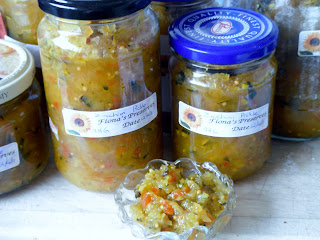Yesterday I had to take Daniel to his pick up spot for work and the day was a typical Autumn day complete with the cold and mist, but this eventually lifted to a warm sunny afternoon.

On the way back home I realised I was reciting a little rhyme from my childhood. It was a nursery rhyme in a book I’d had. The picture was similar to this one and the rhymes were one’s you don’t hear much these days like Doctor Foster, A Tenner a Dollar, There was a crocked Man and others.
I had forgotten some of the words so I googled it, as you do, and found the original rhyme had a lot more verses and really had nothing to do with the man clothed all in leather!!
I knew the ryhme as something like this but had forgotten the words which started the greeting...
'He began to compliment

And I began to grin.'...
One misty moisty morning,
When cloudy was the weather,
I chanced to meet an old man,
Clothed all in leather.
He began to compliment
And I began to grin.
How do you do? And how do you do?
And how do you do again?
However I discovered as I googled further the bit I couldn’t remember had different versions.
Nursery Rhyme lyrics, origins and history
 One misty, moisty, morning,
One misty, moisty, morning,
When cloudy was the weather,
There I met an old man
All clothed in leather
All clothed in leather,
With a cap under his chin.
How do you do?
And how do you do?
And how do you do again?
The rhyme then goes on to meeting a maid who the writer eventually marries. So it was a man who wrote it from his point of view not a little girl as I had always imagined it to be.
English Traditional (arr. Steeleye Span)
One Misty Moisty Morning
One misty moisty morning, when cloudy was the weather,
I chanced to meet an old man a-clothèd all in leather.
He was clothèd all in leather, with a cap beneath his chin,
Singing 'How d'ye do and how d'ye do and how d'ye do again'.
This rustic was a thresher, as on his way he hied,
And with a leather bottle fast buckled by his side.
He wore no shirt upon his back, but wool unto his skin,
Singing 'How d'ye do and how d'ye do and how d'ye do again'.
I went a little further and there I met a maid
'A-going, a-milking, a-milking sir' she said.
Then I began to compliment and she began to sing,
Singing 'How d'ye do and how d'ye do and how d'ye do again'.
This maid her name was Dolly, clothed in a gown of grey,
I feeling somewhat jolly persuaded her to stay.
And straight I fell a-courting her in hopes her love to win,
Singing 'How d'ye do and how d'ye do and how d'ye do again'.
I having time and leisure, I spent a vacant hour
A-telling of my treasure while sitting in her bower.
With many kind embraces, I stroked her double chin,
Singing 'How d'ye do and how d'ye do and how d'ye do again'.
I said that I would married be, and she would be my bride,
And long we should not tarry and twenty things beside.
I'll plough and sow and reap and mow, and you shall sit and spin,
Singing 'How d'ye do and how d'ye do and how d'ye do again'.
Her parents then consented, all parties were agreed,
Her portion thirty shillings, we married were with speed.
Then Will the Piper he did play, whilst others dance and sing,
Saying 'How d'ye do and how d'ye do and how d'ye do again'.
Then lusty Ralph and Robin, with many damsels gay,
Did ride on roan and dobbin to celebrate the day,
And when they met together, their caps they off did fling,
Singing
'How d'ye do and
How d'ye do and
How d'ye do and
How d'ye doooooo .....
... and How d'ye do again!'.
 The food was prepared from the book, High Tea at The Victoria Room ( recipes from The Victoria Room in Sydney, Australia) and included wonderful bite-sized sandwiches, scones with jam and cream, lavender shortbread and other High Tea treats.
The food was prepared from the book, High Tea at The Victoria Room ( recipes from The Victoria Room in Sydney, Australia) and included wonderful bite-sized sandwiches, scones with jam and cream, lavender shortbread and other High Tea treats.





















